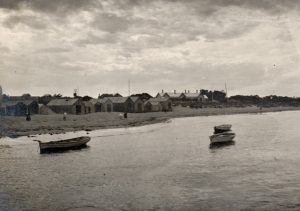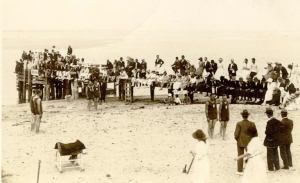
Barwon Heads, long an escape destination for heat and smoke-addled city and suburbanites, has a pretty pictorial history with its boatsheds, river craft, cypresses and hedges, bridge, piers and jetties.
It was a quiet fishing village for many years after white settlement, officially becoming a town in the 1870s. It was initially known as Point Flinders.
The town became a popular getaway in the early 1900s as Melburnites and Western District families moved in, building fine homes, many of which survive to the present.
Barwon Heads’ impressive golf club followed soon after, as did Victoria’s longest timber bridge, a magnificent timber stringer bridge, spanning the Barwon and linking the town to Ocean Grove.
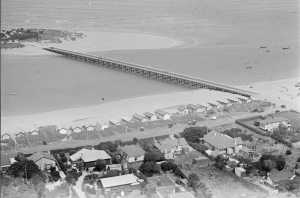
The latter was an anxiety for fisherman worried they’d be unable to sail under the bridge. Engineers dreamed up collapsible masts and other ways around the problem, but without resolution, and the fishing fleet was forced to move to the jetty at mouth of the river.
Photos surviving from those times are unabashedly romantic, sentimental and nostalgic.
A curious image from a year or two earlier, in 1925, shows the jetty hosting a minor crowd of well-suited and well-hatted folk watching a surf lifesaving competition on the sand.
Earlier shots again capture a rowboat jaunt, the bluff in the background and female passengers garbed heavily from wrist to ankle and the heads all but bee-keeper protected by hat and scarf.
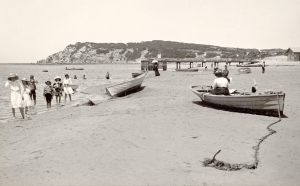
Detailed shots from 1936 by aerial photographer Charles Pratt show at least 40 riverfront boatsheds and bathing boxes along with substantial homes, big back yards, water tanks, windmills, patent Barwon Heads hedges and running-board jalopies viewed these days more as gangster getaway rides as much as the high-end luxury items they were in the day.
The Barwon Heads pub with its Spanish façade, the golf club stark in the links behind town and Thirteenth Beach are all evident, even the handsome former cypresses of Hitchcock Avenue. So too is a generous amount of open space that hasn’t exactly survived the town’s influx of newcomers and development.
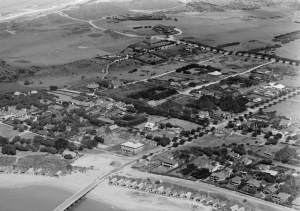
A possible early iteration of SeaChange’s Diver Dan jettyside shack appears in one 1910 image featuring a captivating low-tide scene of boats, kids and beachcombers enjoying the seaside climes.
The bridge, of course, has been subject of community angst more than once if you remember the uproar about relocation before its recent rebuild. Not totally unlike the problems attendant to SeaChange’s barricaded bridge to Pearl Bay.
The original 1920s stink by the fishing fleet was preceded by plans for a pontoon ferry crossing. Much cheaper than a bridge but Bellarine and South Barwon councils dragged their heels for yonks, costs rose dramatically as did traffic and with it the realisation a pontoon simply wouldn’t cut it.
The bridge opened December 24, 1927 – followed a day or two later by an influx what would grow over time to become a traditional Christmas traffic gridlock.
It’s a long way today from those times when an oarsman named Tom Abenathy rowed people across the Barwon for the princely sum of sixpence a trip. Can’t imagine what something like that would cost today.
This story appeared in the Geelong Advertiser 11 August 2025
